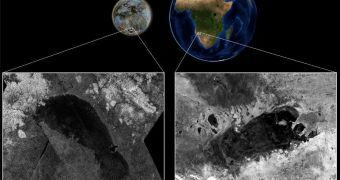A landscape feature similar to the Etosha Pan in Namibia, Africa, was found on the surface of Titan, Saturn's largest moon, and one of the most interesting celestial bodies in the solar system, experts say.
Both features are now cataloged as ephemeral lakes, meaning that they only fill with liquid once in a while. Morphologically, they are basically large, shallow depressions, geologists explain.
The fact that such a formation was found on Titan indicates that more similarities exist between this Moon and Earth than experts first predicted. The most important difference is that the ephemeral lake on Titan fills up with liquid hydrocarbons such as methane and ethane, not water.
In fact, all atmospheric cycles and processes that go on on the large moon are based on this class of chemicals. Other than that, phenomena including lightning and storms are present there as well.
The observations that revealed Titan's Ontario Lacus to be similar to the African Etosha Pan were conducted from aboard the NASA Cassini orbiter. The spacecraft has been analyzing the gas giant, its moons and its ring system since July 1, 2004.
According to Cassini data, Ontario Lacus is a little smaller than Ontario Lake, but only a few meters deep when full. The depression it forms on is actually an extremely shallow and flat sedimentary basin.
In addition to the behavior of the lake itself, scientists learned that even the climate conditions in the area where Ontario Lacus lies are similar to those in the region of Namibia where Etosha Pan forms.
Observations conducted between December 2007 and January 2010 revealed the existence of small channels at the southern boundaries of the shallow depression, suggesting that this is the route through which liquid hydrocarbons sweep in when the lake forms.
Details of the new investigation, which was conducted by a team of experts at the Université de Nantes, in France, and led by investigator Thomas Cornet, appear in the latest issue of the journal Icarus.
“These results emphasise the importance of comparative planetology in modern planetary sciences: finding familiar geological features on alien worlds like Titan allows us to test the theories explaining their formation,” adds Nicolas Altobelli.
The expert holds an appointment as a project scientists for Cassini–Huygens at the European Space Agency (ESA). Titan and Enceladus are both Saturnine moons that could potentially sustain life, which is why so much attention is being paid to them.

 14 DAY TRIAL //
14 DAY TRIAL //